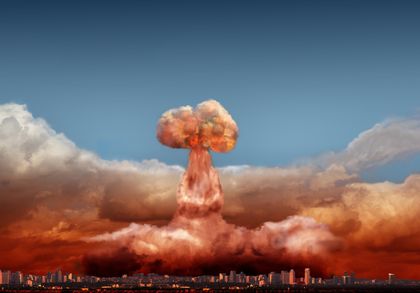Manhattan Project

Nuclear scientists knew in the 1930s that there was a tremendous amount of energy locked in the atomic nucleus. The problem was how to access this energy. With the discovery of nuclear fission in Germany by Otto Hahn, Lise Meitner, and Fritz Strassmann in late 1938 and the subsequent explanation of the process by Meitner and Otto Frisch, many scientists who had been forced to flee from Europe became concerned that Germany might somehow take advantage of this discovery and develop weapons based on nuclear energy. Germany had many competent nuclear scientists, access to heavy water in Norway, quantities of uranium oxide, and a strong engineering history. In the fall of 1939, Leo Szilard, a Hungarian-born physicist who had fled Germany for America, drafted a letter with Albert Einstein to send to President Franklin Roosevelt under Einstein's signature to warn Roosevelt that weapons could be created using a nuclear chain reaction in uranium and that it was very likely that Germany had started working on a uranium bomb. This letter led to the formation of the Advisory Committee on Uranium. The committee did little, however, until Rudolf Peierls and Frisch, working in England, made detailed calculations about the feasibility of nuclear weapons and proposed some possible approaches to making an atomic bomb.
Although government support was relatively weak, important nuclear-science discoveries, unannounced for security reasons, were made in the United States in 1940 and 1941. Potential pathways for enriching 235 U, the self-fissioning isotope of uranium, were developed, and Glenn Seaborg and Arthur Wahl produced plutonium, an element that had great potential for use in a nuclear weapon. In December 1941, President Roosevelt authorized the formation of the Manhattan Engineer District of the Army Corps of Engineers ( "Manhattan Project" ) as the organization that would oversee the development of the atomic bomb. Groups of scientists, some of whom were already working on nuclear energy research, were organized to work on various aspects of the bomb project. One such project was called the Metallurgical Laboratory at the University of Chicago, where Italian-born physicist Enrico Fermi and other scientists worked on the construction of the first nuclear reactor, powered by uranium enriched in 235 U.
The Manhattan Project officially began on September 23, 1942, when Colonel Leslie Groves was named director of the project. Groves acquired production sites at Oak Ridge, Tennessee, and Hanford, Washington, and he brought in Robert Oppenheimer, a physicist from the University of California at Berkeley, as the scientific director at Los Alamos, New Mexico. Los Alamos was to be the center of physics research, engineering, and weapons design. Oak Ridge was to be the site to enrich 235 U, and Hanford was to produce plutonium in nuclear reactors. Many of the country's leading chemical and engineering firms were called in to design and construct these production facilities
Oak Ridge was to produce uranium enriched in the self-fissioning isotope 235 U by gaseous diffusion of the volatile compound UF 6 at the K-25 plant, a facility more than a mile long, and by electromagnetic separation at the Y-12 plant. Nuclear reactors were built at Hanford to produce plutonium from natural uranium, 238 U. Processes were developed to chemically separate and purify the plutonium isotopes 239 Pu and 240 Pu. Scientists from Great Britain also played key roles in the efforts at Los Alamos, and they were instrumental in developing the functional design of the atomic bomb. Work went on at a feverish pace during 1943 and 1944, and it was estimated that an atomic weapon would be completed by early 1945.
In the spring of 1945, preparations began in the Pacific for the use of the atomic bomb. On May 8, 1945, Germany surrendered, and the project was then focused solely on Japan. On July 16, 1945, a test device code-named "Gadget" was detonated at the Alamogordo Bombing Range in New Mexico as part of Project Trinity, the first explosion of a nuclear weapon. The success of the first test of a nuclear weapon was a testament to the ability of the leadership of the Manhattan Project to carry out an unprecedented industrial project, with the world's most talented scientists

cooperating and focusing on a single goal. That the people involved in the Manhattan Project were able to achieve such a spectacular success working in a realm of utmost secrecy in isolated locations was a most singular achievement.
On August 6, 1945, after Japan refused to surrender unconditionally, the first atomic bomb, named "Little Boy," a 235 U-based bomb, was dropped over Hiroshima, Japan. Three days later, "Fat Man," a plutonium-based weapon, was dropped on Nagasaki.
Whether Germany really attempted to build an atomic weapon is debated even today. German scientists, led by physicist Werner Heisenberg, certainly had the talent to build a device. Germany had access to large uranium mines in Czechoslovakia and produced heavy water, a form of H 2 O in which the hydrogen atoms have an extra neutron, in Norway. Most likely there never was a serious effort in Germany to build an atomic weapon, possibly as result of sabotage of the project by Heisenberg or because of a lack of interest by Adolf Hitler.
SEE ALSO Einstein, Albert ; Fermi, Enrico ; Heisenberg, Werner ; Meitner, Lise ; Nuclear Fission ; Oppenheimer, Robert ; Radiation ; Seaborg, Glenn Theodore .
W. Frank Kinard
Bibliography
Frayn, Michael (2000). Copenhagen. New York: Anchor Books.
Rhodes, Richard (1986). The Making of the Atomic Bomb. New York: Simon & Schuster.
Comment about this article, ask questions, or add new information about this topic: